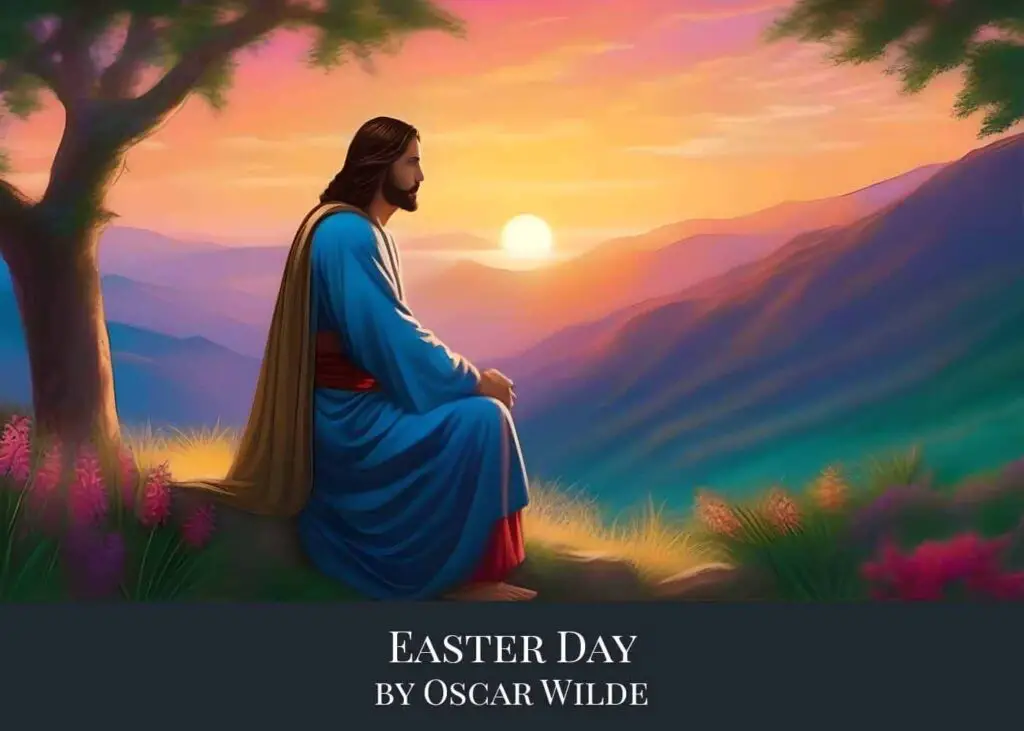
Easter Day by Oscar Wilde
“Easter Day” is a captivating poem by Irish playwright and poet Oscar Wilde, delving into themes of spirituality, faith, and the contrasts between worldly grandeur and divine simplicity. As with many of Wilde’s works, it offers a thoughtful reflection on deeper truths wrapped in elegant prose. For those interested in exploring more of Wilde’s poetic genius, “Easter Day” is featured in Wilde’s first poetry collection Poems. An online book of Poems is available at PageVio.
1. The Poem
The silver trumpets rang across the Dome:
The people knelt upon the ground with awe:
And borne upon the necks of men I saw,
Like some great God, the Holy Lord of Rome.
Priest-like, he wore a robe more white than foam,
And, king-like, swathed himself in royal red,
Three crowns of gold rose high upon his head:
In splendour and in light the Pope passed home.
My heart stole back across wide wastes of years
To One who wandered by a lonely sea,
And sought in vain for any place of rest:
‘Foxes have holes, and every bird its nest.
I, only I, must wander wearily,
And bruise my feet, and drink wine salt with tears.’
Size: 8″ x 12″ (2:3 ratio)
Format: PDF
Copyright information: For personal use only
Note: Actual poster background color is white. For the sample poster, the background is made gray for illustration purpose.
2. Easter Day Analysis
This poem touches upon the contrast between the grandeur and opulence of institutionalized religion and the humble beginnings and struggles of its founder, Jesus Christ. Let’s break down the poem for a clearer understanding:
Lines 1-8
These lines depict a grand scene taking place in a massive cathedral or dome. Silver trumpets are announcing the arrival of a very important figure. The “Holy Lord of Rome” is the Pope, who is being carried on the necks of men, indicating his elevated status among the people. The Pope’s white robe is a symbol of purity, while the royal red represents his power and authority. The three crowns on his head could allude to the Papal tiara, traditionally worn by Popes, symbolizing the triple power of the Pope: “Father of kings, governor of the world, Vicar of Christ”. These lines showcase the majesty and opulence associated with the Pope and the Catholic Church.
Lines 9-14
The tone shifts in the second part of the poem. The speaker’s heart is drawn back in time to the humble figure of Jesus Christ (“One who wandered by a lonely sea”). Jesus, despite being the central figure in Christianity, led a life marked by simplicity, hardship, and sacrifice. The verses “Foxes have holes, and every bird its nest” are references to a passage in the Bible (Matthew 8:20) where Jesus mentions that while animals have places to rest, he has nowhere to lay his head. The final lines depict the suffering and pain Jesus endured in his life, symbolized by bruised feet and the metaphorical “wine salt with tears.”
In essence, the poem contrasts the grandeur and splendor of the Catholic Church, represented by the Pope, with the simple, challenging life of its founder, Jesus Christ. The opulence and majesty of the Church’s earthly power starkly contrast with the humble beginnings and sacrifices of its spiritual leader. This juxtaposition can lead readers to reflect on the disparities between spiritual teachings and institutional practices or the distance between earthly authority and divine humility.
3. Conclusion
Should “Easter Day” appeal to you, delve into additional poetry by Oscar Wilde.